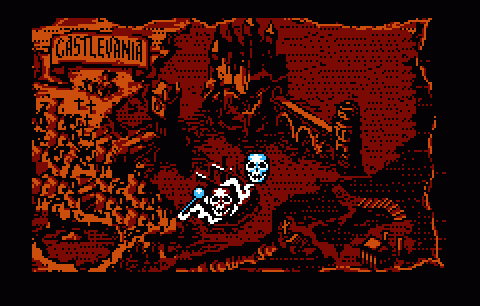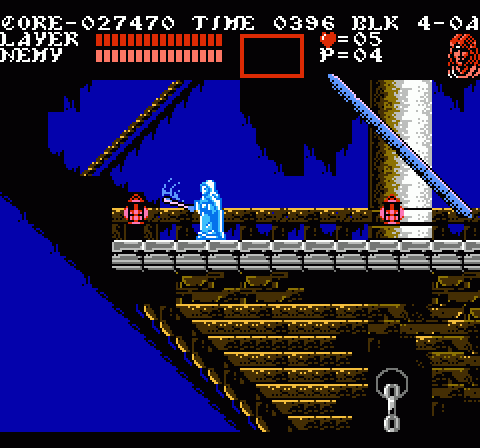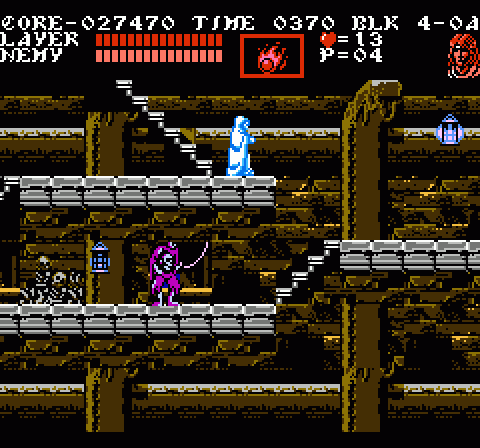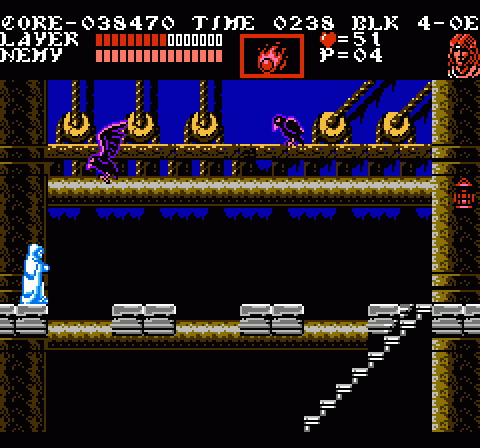Dracula’s Curse splits midway through Block 3, giving you two completely different paths through the game. We’ll be following the path we saw a portion of yesterday to its conclusion before exploring the alternate route. This puts us in Sypha territory, which (based on the stage numeration) represents the alternate path to the castle. I guess I just can’t do anything right.

Block 4-0A and onward provides a shortcut to Castlevania via boat. The idea here is to kick everyone’s butt on the boat, commandeer it, and ride it across the lake rather than taking the long way through the catacombs. But, huh… something about that course marker seems a little weird. Ah, probably nothing to worry about.

Block 4-0A marks a return to the series’ trademark “logical stage design” philosophy with a vengeance. This level is set on a boat, and if you lay out the map screen-by-screen, the level structure describes the shape of that boat. The lower paths are set against the hull, while the upper screens span the deck and main cabin. It’s kind of fantastic — a welcome sign that the discipline that helped the original Castlevania excel wasn’t lost amidst the Simon’s Quest sprawl.

In terms of stage design, Block 4 dials things back quite a bit. There aren’t any gimmicks that really catch you by surprise in the first half of the level — a handful of moving platforms, but mostly just a string of platforms connected by stairways. The enemies here — Dullahan-inspired pirates who lunge at you to stab forward with their rapiers — are perfectly suited to the environment. Because you walk slowly on stairs, you’re left very vulnerable to their impressive reach; the Dullahans can reach out and stab you from half a screen away. You really have to pay careful attention to their actions to avoid being reamed… especially if you’re controlling Sypha, who (like Grant) takes more damage from enemy attacks than Trevor does.
Sypha’s more useful here than that last sentence would suggest. The somewhat low-key nature of the level gives you time to acclimate yourself to Sypha’s quirks, but it also shows off her strengths.
Oh, right, spoiler: Sypha’s a woman.
Sypha’s physical attack, a staff, barely has any more range than Grant’s stab. And it inflicts the same damage as his dagger, or Trevor’s unboosted whip. The thing is, though, you really shouldn’t be using Sypha’s melee attack, like, ever. Her subweapons take the form of three different elemental spells, and they’re amazing. The skill you most often acquire is her fire spell, which costs one heart and offers the same range as Trevor’s whip. Unlike the whip, however, it doesn’t root Sypha to the spot; she pauses briefly to fire it off but doesn’t have to wait for the whole animation to play out before she can move again. But that’s not all. The fire spell also happens to be twice as powerful as Trevor’s fully charged whip. Like Prometheus, once Sypha discovers fire, the world is her oyster. You’ll honestly rarely find reason to go back to Trevor once you start chucking spells… because, believe it or not, fire is Sypha’s weakest magic.
The great thing about Castlevania III is that every support character has value, though, and each one has his or her own fan base.

At the end of Block 4-0C, you discover what was so weird about that map screen: A boss! Sure, Castlevania trained you to expect a boss at the end of every third stage, and Medusa here keeps that tradition intact… but she (he?) is only a mid-boss. There are two entire stages to conquer after this, along with another boss.
Thankfully, Medusa (He-dusa?) isn’t too terribly difficult to best. He sticks to the right edge of the screen and attacks with snakes, with plenty of telegraphing before each action. The use of snakes as bolts fired from his bow — presumably as some kind of anachronistic pop culture reference — is a neat touch, but he shouldn’t pose any real challenge. Especially since Sypha’s magic roasts him like he’s the guest of honor at a Texas rattlesnake cookout.

The cruel prank here is that the stage grows considerably trickier beyond Medusa. You continue facing the same enemies as before, but the ground becomes far more treacherous. The ship’s masts are unsteady ground that rotates beneath you (a neat trick for the NES), while the off-color blocks crumble if you stand on them too long. The spike in difficulty may seem a little cruel coming after covering as much ground as you’d have dealt with in a single stage of the original Castlevania and a boss, but that’s Dracula’s Curse for you.

This is typical of the kinds of situation Blocks 4-0D and 0E like to throw at you. Pits, birds, and certain doom. I guess this is one of those places Trevor comes in handy: The axe subweapon does wonders against these high-up enemies.

Should you manage to survive all the way to the end of the stage, Trevor and Sypha (or Trevor and Grant) face off against a new kind of boss that puts in several appearances throughout the course of the adventure: A drifting spirit that possesses multiple creatures in sequence. You can’t directly hurt the spirit, but you don’t need to. Once you defeat all its hosts, it explodes anyway.

Its first hosts are… the mummies from Stage 09 of Castlevania. They move and attack almost exactly the same way, lumbering along slowly and flinging fragments of their wrappings at you. In this situation, they’re actually a lot easier to face down than they were in the original game, since they initially appear at the left side of the screen and you don’t have to worry about being surrounded unless you play really poorly.

The second host is a reprise of Block 3-04’s Cyclops. He requires a little more effort this time, since you can’t simply jump up out of his range and drop down at your leisure. But otherwise, it’s the same business as before.
This battle offers your first true glimpse of the teamwork mechanic of Dracula’s Curse. Sypha and her fire spell are incredibly effective against the mummies, but she’s much trickier to use against the Cyclops due to the placement of its vulnerable eye. The eye is too high to hit with fire while standing on the ground, and too low to hit with fire while on the platforms. Since Trevor can duck and whip, he’s perfectly in line to smack the Cyclops’ eye, whereas Sypha’s fire whiffs right on over its head.
I’ve never actually used Grant for this stage, but I assume it’s generally trickier due to his limitations, though there are a few locations that appear to have been designed to allow him to sneak on past particularly difficult encounters. Interestingly, there are also a handful of spots that even Grant can’t reach: Enticement for the second quest.
I’d guess that “Medusa as archer” was popularized by the excellent stop motion Medusa scene in Clash of the Titans. In fact, I’d venture that most of the Greek myth subset of Castlevania critters came more from Harryhausen than the original sources (skeleton knights, moving armors, cyclops, hydras, obnoxious harpies).
I know it’s how it appears in the games, but this definition of “stages” is really throwing me. The original game had six stages and the mummies were the boss of the third. Oh well, that’s my problem.
This game really does get off to a very strong start, doesn’t it? In my opinion, the next stage is the first “blah” one on this route and probably the weakest link, although it does have its unique (and aggravating!) twists.
Anyway, these writeups are great and it always brightens my day to see an update.
I should probably be more consistent in my use of terminology. Level = collection of stages; stage = collection of segments; segments = series of screens.
I can’t believe I forgot about Clash of the Titans after seeing it every year I took Latin, but you’re totally right. Though I’d give more credit to Hammer and Universal horror flicks for the series’ overall boss and bestiary ethos than Clash.
The Medusa gender swap’s a case of NoA censorship, of course. Akumajou Densetsu Medusa’s got naked (nipple-less) breasts. Still don’t know how SC4’s Medusa slipped by unscathed.
I hadn’t thought much of the properties of Sypha’s magic, but I’m definitely interested in experimenting with it now. I’ll try it by name code when I do, since, I’m not exactly anticipating getting stabbed by Dullahans or fighting three bosses in one stage on my test run..
But yeah, everyone has something to offer. Grant can climb all over the set dressing and shares some of Trevor’s sub weapon types (I like to stick Grant with an axe while Trevor has a cross or holy water), Sypha has heavy hitting magic, and Alucard…Well, we’ll be getting to him in a few updates, I’m sure.
Ironic that the wizard would be better for the pirate ship than the pirate.
Ha! Though admittedly, Grant got turned into a ghost pirate, so he may not actually have been the best pirate.
I completely disagree, Grant is awesome in this stage. He can climb on the ceiling and skip huge sections of stage, and he can actually skip the below-deck section just before Medusa by climbing over the wall above.
Yeah, but this actually gets down to why I don’t like Grant so much. I feel like in cheating myself if I skip chunks of the game, and Grant is all about skipping over difficult parts.
To Parish: I agree. I was referring specifically to the monsters that don’t fall under the Hammer/Universal umbrella, and creatures from Greek myth (or at least pop culture depictions of Greek myth) make up a significant chunk of that remainder. I guess skeletons can belong to either camp, but given how iconic the scene from Jason and the Argonauts is, I’d lean toward that. Heck, a few Rondo bosses even do the “appear inconspicuously in the background” intro that they loved to do with old stop motion critters.
It’s a testament to your writing ability, Parish, that I am engrossed in this series of articles despite having very little interest in the Castlevania series.
One of the things I loved about Ecclesia is how it brought back the horror movie enemy themes, using moderns one this time. Stuff like Leatherface becoming Mad Butcher and the girl from The Ring becoming Banshee.
It’s creepy to think that Medusa is slithering around in the innards of a ghost ship in the middle of the ocean. What is she (or “he,” “The Sentinal Man” - as coined by Nintendo Power) doing there?
It makes sense and is a nice bit of implied storytelling if the seemingly self-guiding ship only exists to pick up and transport monsters to Drac’s castle in preparation for his rule. Though, IGAvania essentially killed such a thought-train (and several others) by giving Dracula “possession” and direct control of his demonic followers.
Hmm, where was that mentioned? I don’t remember seeing that. Are you implying it from Soma’s power of domination?
Yeah-the whole deal with “ownership” of the souls.
It makes it seem less like Franky, the Mummies, and the rest have a choice in all this. They’re not, as coverage of the games used to suggest, a bunch of buddies who voluntarily showed up for the party-they’re kind of obligated to be there.
There was more a tinge of mystery when I thought it the former.
@jparish: Yeah, I guess I could understand that view on Grant, but I see him more as an advantage on the platforming front in a harsh and cruel world where one wrong move leads to death. Even with his mobility and climbing, I’ve still had many deaths.
Anyway, if Grant’s climbing skills or Al’s bat transformation are cheating the player out of platforming, couldn’t Sypha’s magic spam also be considered cheating the player out of combat?
Yeah, Sypha is just no fun to use. It’s like using legendaries in Pokemon, sure you can wreck everything in one hit, but you don’t feel like you’ve accomplished anything. Grant’s controls are just unwieldy enough to feel like I’ve still accomplished something when I’ve skipped a portion of a stage with him.
Again, I feel the opposite — Sypha’s strengths and weaknesses are the best complement to Trevor’s, and the battle at the end of the ghost ship demonstrates how they make a great team if you know when to swap them.